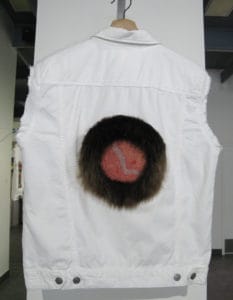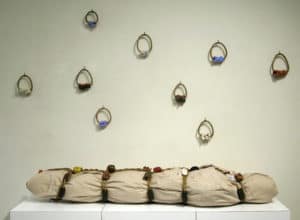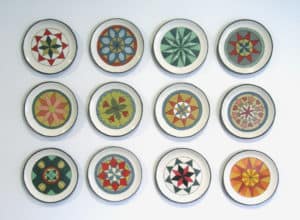Written by: Maia Stark, Exhibitions & Education Coordinator

Crowned by Beaver; Maker of Space (Katherine Boyer), 2017: Seed beads, Stroud cloth, beaver pelt; beadwork. Exhibition: Scutelliphily, 2017.
My experience working with the Saskatchewan Craft Council and as a practicing artist has given me a unique perspective when considering exhibition applications. On one hand, I empathize and understand how much work it is to prepare an exhibition application, and the pressure and nervousness of sending it in! As a person who works with a gallery, I also understand the frustration gallery coordinators or curators can feel when an application is not hitting all the nails on the head. I’d like to use my resulting experience to offer some tips for artists who want to submit a strong application.
1. Double Check the Application Requirements
When you begin working on your application, read through the gallery’s required materials very carefully. Make sure you can supply all the requested material (Written proposal, CV, image list, etc.,) and make sure you supply them in the requested way.
E.G. Is there a max word count or page amount? Do they require that you name your image files a certain way?
Understanding and following these requirements is important for a strong application. There are very good reasons that galleries ask for materials with certain requirements, I promise they aren’t just making you jump through hoops! Here are a few examples:

Shroud for a Green Burial (Puck Janes), 2012: 100% printed cotton, jute rope, clay and glazes, miscellaneous stuffing. Exhibition: Creativity and Spirituality, 2012.
Imagine you run a gallery and receive dozens of applications each year. You request that the written proposal is only 2 pages– long enough so that you understand the idea, but short enough that you have time to read through all the applications carefully. Then imagine that several artists send you written proposals that are 10 pages long… in size 9 font. You can’t read the first two pages and grasp the idea if they chose to describe it over 10 pages. Some galleries will not accept an application for consideration if the applicant makes this kind of mistake, they simply do not have the time to read so many extra pages. As well, it means that the artist did not read the application guidelines carefully, which, unfortunately, could form a poor impression.
The above is a clear example of why a gallery would ask for a max amount of pages; however, some of these requirements might not seem all that important. For instance, what’s the big deal about emailing images?

Cathy Terepocki. Kitchen Quilt, 2015, Black clay, porcelain slip, coloured underglaze and coloured slip; screen-printed using slip-transfer method (plaster, hand-painted). Exhibition: The Narrative Dish, 2015.
Another thing a gallery might request is that your images are sent a certain way. At the SCC we request that images are not sent through email. This is a new requirement after years of encountering issues with emailed image files. An email can only attach files up to a certain size, so an artist often has to send multiple emails in addition to their application. There is also a risk the email program identifies these large files as spam. There is a simpler and more organized way to send your images. Dropbox and WeTransfer are both free image sharing programs that make sharing larger files very simple. Many galleries are requesting that artists send files this way – I’d recommend setting up an account and becoming familiar with either or both websites.
Some galleries will let you know exactly what to send them and how. Make sure to check that you are prepared to follow the requirements. The SCC application package provides a complete list of everything we require.
If a gallery doesn’t give you a list of required documents, refer to other gallery guidelines for an idea of what you could put together! Or, you can always contact the gallery and ask their preference– they will likely be happy that you took the initiative to get in touch. Many galleries are happy to help with questions about their application process!
2. The Proposal
The written proposal is the most difficult document to write. Here are a few guidelines to think about:
a. Describe the general idea
I find it helpful to think in terms of genres or themes. What genre or theme does your work fit into? Is the artwork about form, light, narrative, introspection, tradition, politics, or community? Does the work come out of personal experience, research, or theory? Does the work draw on art history, or is inspired by a particular movement? Figure out one or two key words that best describes the concept, and make sure we read them in the first two sentences. Rely on those key words in the proposal to remind us what your concept is.
b. Describe what the exhibition looks like
Help us imagine what the space would look like, feel like. What would the audience see as they walk in? How are the pieces displayed or hung? You should have a rough idea of how you would display your artwork, and how this would engage the audience.
If you are proposing work that is not yet made, go into great detail about what the work will be like, how it will be made, how it will be installed, and the steps you’ll take to make it. Consider providing a floorplan sketch, and make sure to use shots of work in progress, sketches, or maquettes for your images. Be as clear as possible.
c. Identify any special requirements
Letting the gallery know, in advance, of any extraordinary circumstances or needs is very helpful. Galleries have budgets that need to be adhered to (if we are to keep existing!), and if an exhibition requires assistance or materials that would cost the gallery funds or extra staff hours, the gallery needs to know in advance. This will not necessarily mean your exhibition application is weaker. Transparency is the best policy for galleries and artists working together! If the idea is strong, a gallery will try to work within such obstacles or discuss options with you.
d. Answer this question: Why?
Throughout your written proposal, make sure to answer the “why” question. Why do you want to show your exhibition at that particular gallery? Why do you want to show that particular work together, those particular artists? Asking yourself this question throughout the proposal is very important. Answering or attempting to answer the “why” shows the gallery that there is a clear connection between your work and the gallery; between the artworks themselves; and, in the case of a group exhibition, the connection between the artists.
3. Proof read; proof read; proof read!
Once you have written your proposal and put your other materials together, proof read! See if a friend can look it over, too – they may catch something you missed.

Installation view, The Good Medicine Show, 2011. Curated by Kathy Schmon and Leslie Potter from the collection of the Gabriel Dumont Institute.
Make sure your spelling is correct and that you’ve said everything the way you want to say it. Check that everything is complete; be sure you have all the images and documents in order. Make sure your CV is up to date and that your contact information is correct.
It’s also very important to check that you’ve addressed the application to the right people! As someone on the “other side,” I can’t tell you how many times I’ve been addressed as the wrong name because the artist or curator made a mistake on the document (either because they didn’t check which staff person to refer to, or because they’ve applied to several galleries and didn’t update the document) or how many times my name has been misspelled. It’s not a deal breaker, of course, but it is part of your impression to the gallery.
4. Try Try Again
If your exhibition application is not accepted, please don’t despair. There are many reasons an exhibition does not get accepted by a gallery. Sometimes you will hear some of the reasoning; more often, you don’t hear what the considerations were. Some of the reasons an application could be rejected include the following:
- The exhibition does not fit in the gallery mandate;
(E.G. A contemporary abstract gallery will not accept realistic figurative works!) - The gallery needs to diversify their schedule— this may be due to the gallery’s Gallery Policy;
(E.G. The SCC showcases a variety of media. If an exhibition schedule happens to highlight lots of one kind of media, we will be less likely to schedule as many similar media the following programming year) - The application was not strong enough. Whether or not the application was rejected due to scheduling or because the application wasn’t strong, it’s incumbent on the artist to work on the application to be better next time. I’ve also felt the bitter sting of rejection – It’s not a good feeling! The best thing you can do for yourself is to keep working!
Always consider what could make the application better.
Maybe the photographs weren’t of the best quality; maybe the concept could have been explained better. Maybe there wasn’t enough work to show in that size of gallery. Maybe the proposed exhibition would benefit from a collaborator. Identify what you think could be improved and do it! Make sure to seek other galleries and consider sending your revised proposal to them. Don’t count on one gallery as your only option!
And don’t give up!
Here are a few links to other articles and blog posts offering other suggestions for writing your proposal and submitting your application.